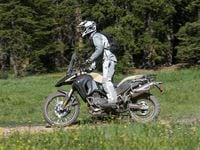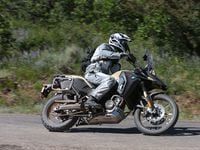They say: "True adventure in lean form"
We say: "Lean no, awesome yes"
Even though this bike is essentially what everyone expected—BMW’s ADV package sprinkled over the reinvigorated 2013 F800GS—I have been truly excited about the newest GS Adventure. The middle GS sibling being given the “Adventure” badge means the usual smattering of long distance and off-road goodies designed to create the ultimate mid-sized ADV bike, and in my view this almost always makes a GS better.
While we’re on the subject, it’s hard to believe that 500 pounds would qualify as “mid-sized”, but such is the world of adventure-touring these days. To be fair, the tank holds a lot of fuel; 6.3 gallons in the plastic under-seat tank, up 2.1 gal. from the standard bike. BMW is quick to point out that 13 of the added 33 lbs. on the Adventure come from extra petrol (we’ll get to the other 20 lbs. in a minute).
The plus side of extra gas is, of course, is extra range, and BMW claims the F800 benefits from 40 percent more roaming capability. At BMW’s suggested “55 mpg at 55 mph” figures that means more than 300 miles per tank, although I found 250 miles to be a more realistic limit when riding casually.
Now, about those other 20 pounds. Not surprisingly, that’s in the form of crash bars mounted at the front of the frame near the motor and along the sides (integrated with the saddlebag mounts), a luggage rack, a bigger windshield and front fender, larger side covers near the radiator, hand guards, and a few other odds and ends. A total of 15 “key changes”, according to BMW. Among the more interesting changes is a visual one. Since the larger tank makes the rear of the bike so much wider, BMW widened the radiator shrouds purely to “communicate a strong presence” and match the back of the bike.
The crash bars near the bottom of the bike are standard, as is the small skid plate under the engine, but if you plan to take your GS-A farther off-road than hard-pack gravel, you will want the factory-option aluminum skid plate. The press bike for my ride in Moab, Utah, was fitted with that option and by lunchtime had provided necessary protection to the underside of the bike. One scar was particularly gruesome, and would have undoubtedly damaged the low-hanging oil filter.
As we have come to expect from BMW, handling in the dirt—even when standing on the pegs—is decidedly agile for such a substantial machine, neatly designed to be narrow in the middle so it doesn’t feel (good thing) like a 500-lb. dirt bike. The 21-inch front wheel rolls over obstacles noticeably better than a 19 in. option and raises confidence with every turn. When the road is paved and the pace is up the larger and heavier front rim makes steering effort higher, but wide bars compensate well. Plus, let’s be honest, you’re not going to set the road-going world on fire with this bike anyway.
Electronics options for 2014 include an Enduro mode for ABS and ASC (traction control), á la R1200GS but don't be fooled, it's not the same system. The mode is similarly useful though, and similarly fun. On the many miles of dirt road we careened through in Utah and Colorado, the Enduro ABS was impeccable. Instead of applying both brakes approaching a corner and worrying about modulation or stalling the engine with the rear brake, generous pressure can be applied to the rear brake and the only consequence is a gentle slide. Initiate the turn and apply more front brake and the slide will grow rapidly, but it is always manageable.
Traction control, too, is excellent, allowing lurid power slides exiting gravel corners without the danger of losing control. If confined to pavement (or for extra-cautious dirt riding) a Road mode is available as well, dialing up the sensitivity for both systems. Expert off-road riders will want both systems off, but the safety net of a capable traction system is unquestionably valuable. I found myself most comfortable with ABS in Enduro mode and ASC switched completely off, while other journos liked the opposite combination. The beauty of BMW’s system is that both can be switched on or off independently.
The 2014 800 Adventure has one more trick up its sleeve; Electronic Suspension Adjustment, or ESA. Again, not the same system from the flagship R1200GS, and it does not include the R1200’s DDS (Dynamic Damping System) which adjusts suspension damping as you ride. The F800GS Adventure’s ESA simply allows handlebar adjustment (3 settings) for rebound damping in the shock. Being it’s already such a tall, soft bike, I preferred the harder Sport setting both on- and off-road.
All of this adds up to confidence inspiration that will encourage you to stretch your own boundaries for adventure touring. That’s where this bike really shines. The larger windshield, despite being nearly vertical, creates a calm pocket of air in the cockpit, even for taller riders. Overall wind protection is superb, although mostly I cursed it during our ride, which saw temperatures at and above 100 degrees. The two-tone, color-matched seat also dares you to keep going and, coincidentally, dares you to stop, as it towers 35 in. above the ground. A lower, all black option is available from the factory free of charge, and sits 33.9 in. high.
An ongoing gripe that consumers and journalists alike have had regarding the F800GS is blowing hot air on the rider’s legs. This GS-A is no different, unfortunately. The wider cowls around the radiator provide more weather protection than the standard model, but that calm air allows the radiator’s heat to linger. One surprise was the 800 Adventure’s transmission, which doesn’t seem quite as ready to take on the world as the rest of the bike. First gear in particular was a little too tall for really technical off-roading—especially with the 800’s light flywheel and an altitude-stricken torque curve—while I was constantly reaching for a 7th gear on the highway.
Overall, we continue to be impressed with BMW’s Adventure packages. There is simply no reason not to give up a little bit of street competence for increased off-road aptitude when the bike is such a capable sport-tourer anyway. Actually, there is one reason, and that’s the part after the “$.” It’s easy to get carried away about how much the ADV goodies improve the F800GS package, but don’t forget that it comes at a price.
Fully loaded, the 2014 BMW F800GS Adventure costs $14,995. That’s dangerously close to the R1200GS’s $15,800 base cost, but does have features not included on the base R1200, like a full suite of electronics and fog lights to name a few. The model shipped to most BMW dealers will be the Premium package, which includes ASC and Enduro modes, heated grips, an upgraded on-board computer, and a center stand, for $14,350. There will be a base model available as well, priced at $13,550, equipped with mounts/racks and crash bars, the large windscreen, hand guards, and all of the other aesthetic do-dads that create the Adventure’s look, but no electronic frills.
These prices are all quite a bit higher than the standard F800GS’s base price of around $12,500, but there is definitely value in the Adventure package. Aluminum saddlebags (top-loading 38 and 44 liter pieces) and top case are factory options, as is an Adventure GPS, and an Akropovic titanium exhaust. The F800GS Adventure is a complex, luxurious, and expensive motorcycle. But once you have it the way you want it there is almost no limit to what or where you can do or go. Truly worthy of the Adventure badge.




















/cloudfront-us-east-1.images.arcpublishing.com/octane/G4MG6OUCJNBSHIS2MVVOTPX65E.jpg)
/cloudfront-us-east-1.images.arcpublishing.com/octane/IIGGWFOTOJGB7DB6DGBXCCMTDY.jpg)
/cloudfront-us-east-1.images.arcpublishing.com/octane/QSTCM6AVEZA5JJBUXNIQ3DSOF4.jpg)
/cloudfront-us-east-1.images.arcpublishing.com/octane/U4I7G625B5DMLF2DVIJDFZVV6M.jpg)
/cloudfront-us-east-1.images.arcpublishing.com/octane/B6XD6LS6IVCQPIU6HXDJSM3FHY.jpg)
/cloudfront-us-east-1.images.arcpublishing.com/octane/ICL63FEDDRDTTMINYICCEYGMDA.jpg)
/cloudfront-us-east-1.images.arcpublishing.com/octane/FCGZHQXRBZFLBAPC5SDIQLVF4I.jpg)
/cloudfront-us-east-1.images.arcpublishing.com/octane/WNOB6LDOIFFHJKPSVIWDYUGOPM.jpg)

/cloudfront-us-east-1.images.arcpublishing.com/octane/X33NU3E525ECRHXLNUJN2FTRKI.jpg)
/cloudfront-us-east-1.images.arcpublishing.com/octane/6KKT5NNL2JAVBOXMZYS5ZO76YA.jpg)
/cloudfront-us-east-1.images.arcpublishing.com/octane/J5RKG5O455GMPGQRF2OG6LRT7A.jpg)
/cloudfront-us-east-1.images.arcpublishing.com/octane/GX2CIZKQVRH2TATDM26KFG2DAE.jpg)
/cloudfront-us-east-1.images.arcpublishing.com/octane/ZWIDYSAKQZHD5BHREMQILXJCGM.jpg)
/cloudfront-us-east-1.images.arcpublishing.com/octane/CYUHJZCTSJCH3MRAQEIKXK7SCQ.jpg)
/cloudfront-us-east-1.images.arcpublishing.com/octane/LKOFINY56FCXJCANJ5M7ZDQUBY.jpg)
/cloudfront-us-east-1.images.arcpublishing.com/octane/4NBPDACMWJH63JQYJVK3QRBDZI.jpg)
/cloudfront-us-east-1.images.arcpublishing.com/octane/KKHQHRR3FJGX7H2IPU6RALMWG4.jpg)

/cloudfront-us-east-1.images.arcpublishing.com/octane/5IOFS5JAE5FOXMNA23ZRAVVYUU.jpg)
/cloudfront-us-east-1.images.arcpublishing.com/octane/CGXQ3O2VVJF7PGTYR3QICTLDLM.jpg)

/cloudfront-us-east-1.images.arcpublishing.com/octane/OQVCJOABCFC5NBEF2KIGRCV3XA.jpg)
/cloudfront-us-east-1.images.arcpublishing.com/octane/OPVQ7R4EFNCLRDPSQT4FBZCS2A.jpg)